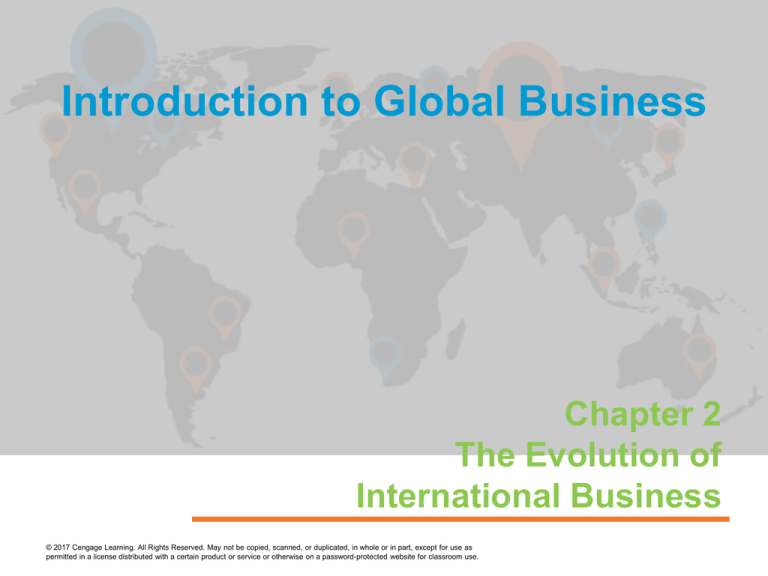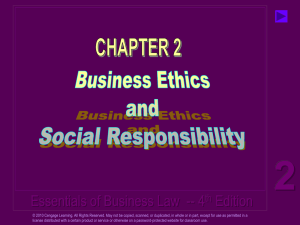
Introduction to Global Business
Chapter 2
The Evolution of
International Business
© 2017 Cengage Learning. All Rights Reserved. May not be copied, scanned, or duplicated, in whole or in part, except for use as
permitted in a license distributed with a certain product or service or otherwise on a password-protected website for classroom use.
After studying this chapter, you should be able to:
1. Briefly explain why trade and foreign investment are
good for society as a whole.
2. Describe the major international trade theories and how
they operate.
3. Evaluate trade policy, the main instruments of trade
policy, and their impact on business, consumers, and
governments.
4. Explain the rationale behind a country’s choice of
managing trade.
© 2017 Cengage Learning. All Rights Reserved. May not be copied, scanned, or duplicated, in whole or in part, except for use as
permitted in a license distributed with a certain product or service or otherwise on a password-protected website for classroom use.
Terms
• International business
– All commercial transactions, both private and public between
nations of the world
• Trade
– The two-way flow of exports and imports of goods (merchandise
trade) and services (service trade)
• Foreign direct investment
– Inflows of capital from abroad for investing in domestic plant and
equipment for the production of goods and/or services and for
buying domestic firms
© 2017 Cengage Learning. All Rights Reserved. May not be copied, scanned, or duplicated, in whole or in part, except for use as
permitted in a license distributed with a certain product or service or otherwise on a password-protected website for classroom use.
Benefits of International Trade
A greater amount
of choice in the
availability of
goods and
services
Competition
results in lower
prices for goods
and services
consumed
© 2017 Cengage Learning. All Rights Reserved. May not be copied, scanned, or duplicated, in whole or in part, except for use as
permitted in a license distributed with a certain product or service or otherwise on a password-protected website for classroom use.
Increased quality
of life and
higher living
standards
Major Theories of International Trade
Mercantilism
Specialization
• The premise that a
nation could only
gain from external
trading if it had a
trade surplus
• Free trade encourages countries
to specialize in the
production of those
goods and services
that they most
efficiently produce
© 2017 Cengage Learning. All Rights Reserved. May not be copied, scanned, or duplicated, in whole or in part, except for use as
permitted in a license distributed with a certain product or service or otherwise on a password-protected website for classroom use.
Factor
Endowments
• Nations primarily
export goods and
services that
intensely use their
abundant factors of
production
Trade Theory Terms
• Factors of production
– Endowments used to produce goods and services:
•
•
•
•
Land (quantity, quality, and mineral resources beneath it)
Labor (quantity and skills)
Capital (cost)
Technology (quality)
• Trade surplus
– When the value of exports exceeds the value of imports; the
opposite of a trade deficit
© 2017 Cengage Learning. All Rights Reserved. May not be copied, scanned, or duplicated, in whole or in part, except for use as
permitted in a license distributed with a certain product or service or otherwise on a password-protected website for classroom use.
Wealth Accumulation as a Basis for Trade
Theory: Mercantilism
• Mercantilism is the oldest form of trade theory.
– Practiced during the 1500–1750 period as Europe moved toward
nationalism
– Wealth—both personal and national—largely determined by the
amount of precious metal owned
• Mercantilists believed that for a nation to be wealthy, it
must export as much as possible and import as little as
possible so that the country would have a trade surplus.
• Mercantilists did not want to see the big picture:
– If all nations increased exports and decreased imports, there would
be a surplus of exports that would lead to unpleasant results.
© 2017 Cengage Learning. All Rights Reserved. May not be copied, scanned, or duplicated, in whole or in part, except for use as
permitted in a license distributed with a certain product or service or otherwise on a password-protected website for classroom use.
Specialization as a Basis for Trade Theory:
Absolute and Comparative Advantage
• Absolute advantage
– The ability of one country to produce a good or service more
efficiently than another
• Comparative advantage
– The ability of one country that has an absolute advantage in the
production of two or more goods (or services) to produce one of
them relatively more efficiently than the other
© 2017 Cengage Learning. All Rights Reserved. May not be copied, scanned, or duplicated, in whole or in part, except for use as
permitted in a license distributed with a certain product or service or otherwise on a password-protected website for classroom use.
Factor Endowments as a Basis
for Trade Theory
• The Heckscher–Ohlin (H–O) theory
– Attributes the comparative advantage of a nation to its factor
endowments: land (quantity, quality, and mineral resources
beneath it), labor (quantity and skills), capital (cost), and
technology (quality)
• Key assumptions of the H–O theory:
– Perfect competition in the marketplace
– Perfect immobility of factors of production among countries
© 2017 Cengage Learning. All Rights Reserved. May not be copied, scanned, or duplicated, in whole or in part, except for use as
permitted in a license distributed with a certain product or service or otherwise on a password-protected website for classroom use.
Factor Endowments as a Basis
for Trade Theory (continued)
• Factor price equalization theory
– When factors are allowed to move freely among trading nations,
efficiency increases, which leads to superior allocation of
production of goods and services among countries.
– Free mobility of factors will lead to efficient reallocation of
resources (factors of production) until price equilibrium is reached.
© 2017 Cengage Learning. All Rights Reserved. May not be copied, scanned, or duplicated, in whole or in part, except for use as
permitted in a license distributed with a certain product or service or otherwise on a password-protected website for classroom use.
Porter’s “Diamond” Model of
National Competitive Advantage
Chance
Firm strategy,
structure, and
rivalry
Factor
conditions
Demand
conditions
Related and
supporting
industries
© 2017 Cengage Learning. All Rights Reserved. May not be copied, scanned, or duplicated, in whole or in part, except for use as
permitted in a license distributed with a certain product or service or otherwise on a password-protected website for classroom use.
Government
The Practice of Trade Policy
• Trade policy
– All government actions that seek to alter the size of merchandise
and/or service flows from and to a country
• Instruments of trade policy
–
–
–
–
Tariffs (custom duties)
Preferential duties
Most favored nation status
Nontariff barriers
© 2017 Cengage Learning. All Rights Reserved. May not be copied, scanned, or duplicated, in whole or in part, except for use as
permitted in a license distributed with a certain product or service or otherwise on a password-protected website for classroom use.
International Trade Organizations
Bretton Woods
International
Monetary
Fund (IMF)
General Agreement
on Tariffs and Trade
(GATT)
World Trade
Organization (WTO)
© 2017 Cengage Learning. All Rights Reserved. May not be copied, scanned, or duplicated, in whole or in part, except for use as
permitted in a license distributed with a certain product or service or otherwise on a password-protected website for classroom use.
World
Bank
Nontariff Barriers
Import Quotas
• Quantitative Restrictions (QRs) limit the amount or number
of units of products that can be imported to a country
Voluntary Export Restraint (VER)
• An arrangement under which an efficient exporting nation
agrees to limit exports of a product to another country for a
temporary period
Domestic Content Provisions
• Regulations requiring that a certain percentage of the value
of import be sourced domestically
© 2017 Cengage Learning. All Rights Reserved. May not be copied, scanned, or duplicated, in whole or in part, except for use as
permitted in a license distributed with a certain product or service or otherwise on a password-protected website for classroom use.
Current Practice of “Managed” Trade
Socioeconomic Rationale
Geopolitical Rationale
•
•
•
•
•
•
• National security
• Protection of critical (strategic)
industries
• Embargoes
Countertrade
Export cartels
Protection of infant industries
Questionable labor practices
Environmental considerations
Health and safety
© 2017 Cengage Learning. All Rights Reserved. May not be copied, scanned, or duplicated, in whole or in part, except for use as
permitted in a license distributed with a certain product or service or otherwise on a password-protected website for classroom use.
Key Terms
international business
trade
foreign direct investment
outsourcing
mercantilism
factors of production
trade surplus
absolute advantage
comparative advantage
factor price equalization
theory
Heckscher–Olin (H–O)
theory
trade policy
tariffs
custom duties
specific tariff
ad valorem tariff
preferential duties
generalized system of
preferences (GSP)
export subsidy
export taxes
© 2017 Cengage Learning. All Rights Reserved. May not be copied, scanned, or duplicated, in whole or in part, except for use as
permitted in a license distributed with a certain product or service or otherwise on a password-protected website for classroom use.
Key Terms (continued)
most favored nation (MFN)
import quotas
voluntary export restraint
(VER)
domestic content provisions
managed trade
countertrade
export cartels
infant industry argument
embargoes
© 2017 Cengage Learning. All Rights Reserved. May not be copied, scanned, or duplicated, in whole or in part, except for use as
permitted in a license distributed with a certain product or service or otherwise on a password-protected website for classroom use.







